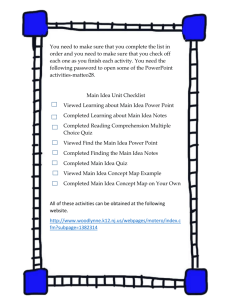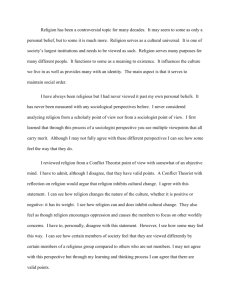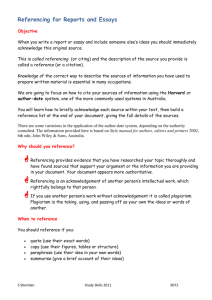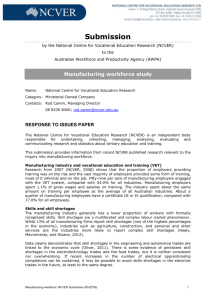Guide to NCVER`s Referencing Style
advertisement
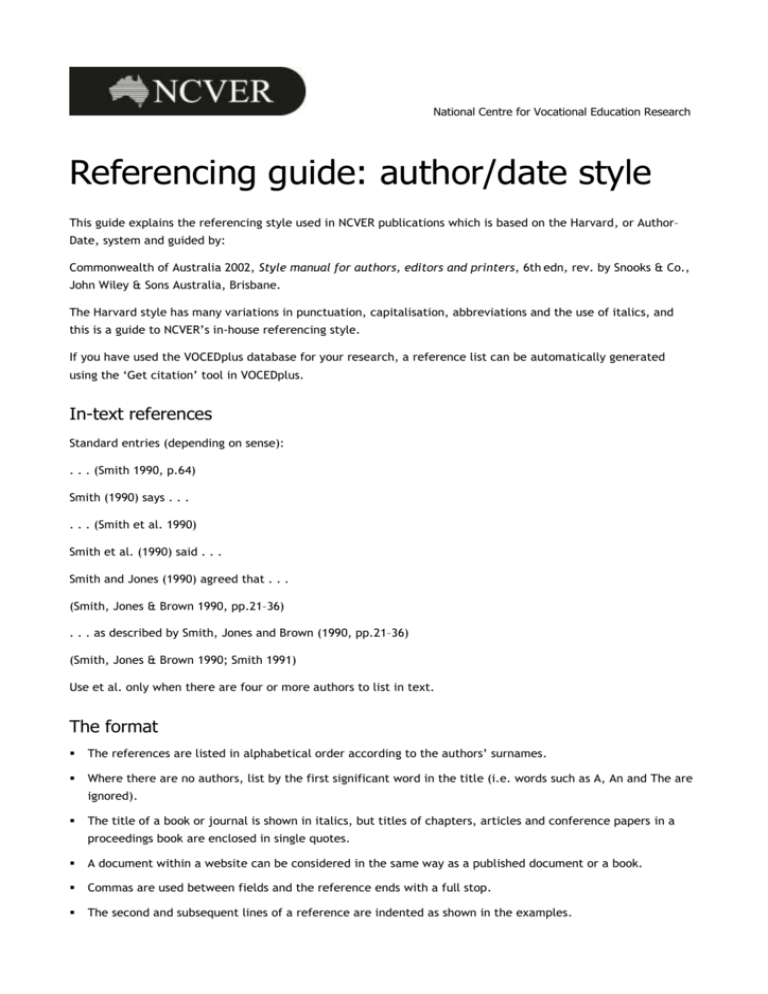
National Centre for Vocational Education Research Referencing guide: author/date style This guide explains the referencing style used in NCVER publications which is based on the Harvard, or Author– Date, system and guided by: Commonwealth of Australia 2002, Style manual for authors, editors and printers, 6th edn, rev. by Snooks & Co., John Wiley & Sons Australia, Brisbane. The Harvard style has many variations in punctuation, capitalisation, abbreviations and the use of italics, and this is a guide to NCVER’s in-house referencing style. If you have used the VOCEDplus database for your research, a reference list can be automatically generated using the ‘Get citation’ tool in VOCEDplus. In-text references Standard entries (depending on sense): . . . (Smith 1990, p.64) Smith (1990) says . . . . . . (Smith et al. 1990) Smith et al. (1990) said . . . Smith and Jones (1990) agreed that . . . (Smith, Jones & Brown 1990, pp.21–36) . . . as described by Smith, Jones and Brown (1990, pp.21–36) (Smith, Jones & Brown 1990; Smith 1991) Use et al. only when there are four or more authors to list in text. The format The references are listed in alphabetical order according to the authors’ surnames. Where there are no authors, list by the first significant word in the title (i.e. words such as A, An and The are ignored). The title of a book or journal is shown in italics, but titles of chapters, articles and conference papers in a proceedings book are enclosed in single quotes. A document within a website can be considered in the same way as a published document or a book. Commas are used between fields and the reference ends with a full stop. The second and subsequent lines of a reference are indented as shown in the examples. If more than one item has been cited by the same author, they should be listed chronologically (from earliest to latest), using a 2-em rule i.e. a 2-em dash (——) is used instead of the author’s name for the second and subsequent entries. If more than one item has been published in the same year, add a, b etc. to the date to differentiate the items. Example Misko, J 2004, The role of Community Development Employment Projects in rural and remote communities, NCVER, Adelaide, viewed October 2005, <www.ncver.edu.au/publications/1505.html>. ——2006a, Vocational education and training in Australia, the United Kingdom and Germany, NCVER, Adelaide, viewed May 2006, <www.ncver.edu.au/publications/1670.html>. ——2006b, Country background report: Addressing the training and assessment needs of adults with low basic skills in Australia, Organisation for Economic Co-operation and Development, Paris, viewed September 2006, <www.oecd.org/dataoecd/60/44/37038515.pdf>. The order in which the information is to be displayed is as follows: Books, reports, journals and book chapters Journal articles Author(s) Author(s) Date (year published) Date (year published) Title (of book, report, journal, book chapter) Article title Title of book (if chapter is being referenced) Journal title Edition (if applicable) Volume number Editors (if chapter is being referenced) Issue number Series (if applicable) Pages of article Publisher Date viewed and URL (if viewed online) Place of publication Page numbers (if applicable) Date viewed and URL (if viewed online) Conference papers Non-book materials Author(s) Author(s) Date (year published) Date (year published) Title of paper Title Conference name Publisher Date viewed and URL (if viewed online) Place of publication Note: Some conference papers are published as part of a volume of proceedings and these are treated as chapters in a book. Material type Unpublished documents Web sites Author(s) Author(s) Date (year created) Date (year created/updated) Title Title (or name and place of sponsor of the source) Unpublished Date viewed and URL The table below shows examples of different document types and how they should be referenced. Document type Examples of NCVER house style Book – no author WELL Workplace English Language and Literacy: effective communication in the manufacturing industry — case studies 2003, Manufacturing Learning Victoria, Hawthorn, Vic. Book – single author McGivney, V 2006, Adult learning at a glance: the UK context, facts and figures 2006, National Institute of Adult Continuing Education, Leicester, England. Book – two authors Monteiro, H & Gentleman, S 2005, NVQs within FE: an investigation into full-time NVQ provision and uptake in the FE sector, Learning and Skills Development Agency, London. Page 2 of 3 Referencing guide: author/date style Document type Examples of NCVER house style Book –corporate author William Angliss Institute of TAFE Council 1997, Ministerial Review for the Provision of Technical and Further Education in the Melbourne Metropolitan Area, William Angliss Institute of TAFE, Melbourne. Book – edited by single editor Phillips, D (ed.) 2000, The education systems of the United Kingdom, Symposium Books, Oxford, England. Book – edited by two editors McLeish, E & Phillips, D (eds) 1998, Processes of transition in education systems, Symposium Books, Oxford, England. Book – different edition Australian Qualifications Framework Advisory Board 1998, Australian Qualifications Framework: implementation handbook, 2nd edn, AQFAB, Carlton, Victoria. Report – part of a series Bunning, F 2006, The transformation of vocational education and training (VET) in the Baltic states: survey of reforms and developments, Technical and vocational education and training: issues, concerns and prospects, vol.4, Springer, Dordrecht, The Netherlands. Documents available online New Zealand Tertiary Education Commission 2006, Developing the second Tertiary Education Strategy: 2007/12, Ministry of Education, Wellington, viewed September 2006, <www.minedu.govt.nz/web/downloadable/dl11445_v1/final-pdf-of-discussion-document.pdf>. Chapter in an edited book Billett, S 2001, ‘Vocational educators: understanding practice at work’, in International perspectives on competence in the workplace: research policy and practice, ed. C Velde, Kluwer Academic Publishers, Dordrecht, The Netherlands, pp.41–64. Chapter in an edited book – two editors (and part of a series) Akyeampong, A 2005, ‘Vocationalisation of secondary education in Ghana’, in Vocationalisation of secondary education revisited, eds J Lauglo & R Maclean, Technical and vocational education and training, vol.1, Springer, Dordrecht, Netherlands, pp.149—225. Journal issue Adults learning, vol.17, no.5, January 2006, National Institute of Adult Continuing Education, Leicester, England. Journal article Abbot-Chapman, J 2006, ‘Moving from technical and further education to university: an Australian study of mature students’, Journal of Vocational Education and Training, vol.58, no.1, pp.1–17. Conference paper not published in a volume of proceedings Lee, T, Ashton, D, Bishop, D, Felstead, A, Fuller, A, Jewson, N & Unwin, L 2005, 'Cutting it: learning and work performance in hairdressing salons', paper presented at the 4th International Conference on Researching Work and Learning, 2005, Sydney, viewed June 2006, <www.projects.education.uts.edu.au/RWL4/RWL4Papers/.doc>. Unpublished report Rushbrook, P 1996, ‘Straws in the wind: the construction of technical and further education in Victoria 19451985’, unpublished. Web site/web pages Ministerial Council on Education, Employment, Training and Youth Affairs 2006, ‘Stepping forward: improving pathways for all young people’, viewed March 2006, <www.mceetya.edu.au/verve/_resources/checklist.pdf>. Non-book material Department of Education, Science and Training, TexSkill & Agenda Communication 2006, LMT TCF training package Cert II & III textile fabrication: WELL resource project, Agenda Communication, Attadale, Western Australia, [CD ROM]. Page 3 of 3 Referencing guide: author/date style
